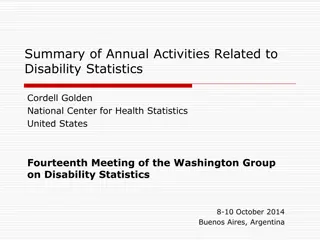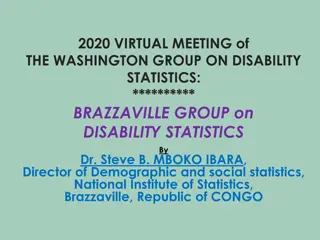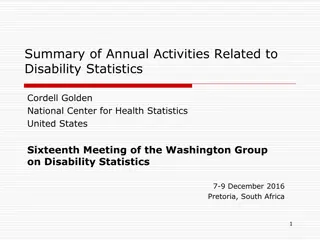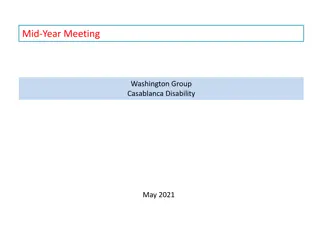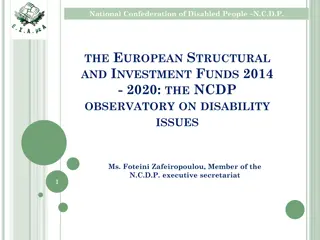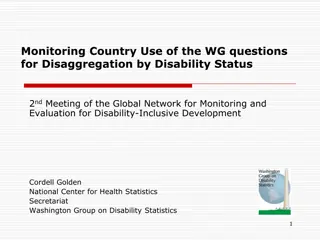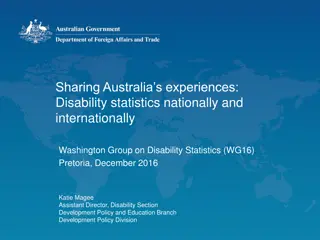Moroccan Experience on Disability Statistics and Policies
The Kingdom of Morocco, through the High Commission of Planning, has been actively involved in collecting data and implementing policies related to disability. The country has signed international conventions and laws to protect the rights of persons with disabilities, focusing on rehabilitation and social integration. The statistical findings from censuses reflect a shift in measuring disability rates based on international standards like the ICF. The efforts made by Morocco emphasize the importance of providing accurate information for better societal integration of disabled individuals.
Download Presentation

Please find below an Image/Link to download the presentation.
The content on the website is provided AS IS for your information and personal use only. It may not be sold, licensed, or shared on other websites without obtaining consent from the author. Download presentation by click this link. If you encounter any issues during the download, it is possible that the publisher has removed the file from their server.
E N D
Presentation Transcript
THE KINGDOM OF MOROCCO HIGH COMMISSION OF PLANNING MOROCCAN EXPERIENCE ON DISABILITY STATISTICS BY ZINEB EL OUAZZANI TOUHAMI Statistician Engineer Directorate of Statistic High Commission of planning Morocco Email: z.elouazzanitouhami@hcp.ma 15 WASHINGTON GROUP MEETING COPENHAGEN DANEMARK 27-29 OCTOBER 2015
Contents National and international relevant references I Initial findings from the Moroccan census on Disability II Disability prevalence from disability survey III Facts about the use of short set of questions on census IV
National and international relevant references: Article 34 The public powers enact and implement the policies designed for persons and for categories of specific needs. To this effect, it sees notably: to respond to and provide for the vulnerability of certain categories of women and of mothers, of children, and of elderly persons; to rehabilitate and integrate into social and civil life the physically sensory- motor and mentally handicapped and to facilitate their enjoyment of the rights and freedoms recognized to all The provisions of the law No 07-92 related to the social protection of disabled persons. The outline law No 97-13 related to disabled persons, adopted the 19 June 2014.
National and international relevant references Morocco signed the Convention on the rights of Persons with disabilities on 30/3/2007. Ratified the Convention and the Optional Protocol on 8/4/2009. Although the constitution formally prohibits discrimination based on race, gender, disability, language, and social status. The constitution states that the government, through laws and regulations, should care and rehabilitate persons with disabilities and special needs to reintegrate them into society. Based in these laws and conventions , and recognizing the importance of the issue of disability , the High Commission of Planning has led his effort to ensure essential and updated information , witch is comparable all over the world
Disability statistics from censuses The identification of disabled persons on 2004 was based on The International Classification of Impairments, Disabilities and Handicaps (ICH), which helped to classify disability into three main categories (Sensory Disability, Mental Disability, Physical Disability). In order to measure the rate of disability on 2014 we referred to the UN standards, fundamentally the international classification of functioning ICF. we considered disabled , anyone with complete disability or having a lot of difficulty in one of the six functional domains namely seeing, hearing, communication, remembering/concentrating, walking and self- care. The results of 2014 cannot be compared to the results of the previous censuses of 1994 and 2004, due to differences in the definitions and approaches.
Disability statistics from censuses: Prevalence of disability and types of Disabilities 2004 Census 2004 counted 680537 people with disability. They represented 2,3% percent of the population. About 56,2% of Moroccan reported having physical disability, followed by sensorial disability 24,9%,, and Mental disability 18,8%. distribution of disabled persons by type of disability Mental 18.80% Sensoriel 24.90% Physical 56.20%
Disability statistics from censuses: Prevalence of disability 2014 In 2014, 4 .1% percent of the Moroccan population were identified as disabled, a total of 1,353,766 people Prevalence rises with age, People aged 60 years and over are much more likely to be disabled (50,6%) than adults from 15 to 59 years (38,3 %) or children under 15 years (10,9 %). Prevalence of disability by age 2014 50.6% 38.3% 10.9% under 15 15 to 59 60and+
Disability statistics from censuses: total disability About 295,431 persons has at least total disability in one of the essential domains (147,152 men and 148,279 women) (0,9%)
Disability statistics from censuses: Prevalence by sex In 2004 men (56,3%) were generally more likely than women (46,7%) to report disabilities 43.7% Males 56.3% Females In 2014,the prevalence did not differ significantly between men and women 47.5% 52.5% Males Females
Disability statistics from censuses: disability and marital status Disability and marital status in 2004 Disability and marital status in 2014 46% 53.1% 39.8% 28% 24% 5.2% 1.9% 2.60% Single Married divorced Widowed Single Married divorced Widowed
Disability statistics from censuses: education 2014 About 73 % of disabled are without any school level, 15% reached the primary school level, 8.5% secondary level and 1.5% attained the higher level. More much efforts should be done to enlarge educational opportunities for persons with disabilities Level of education and disability2014 73% 15% 8.5% 1.5% any level Primary level Secondary level Higher level
Disability statistics from survey National survey on disability was conducted by the Ministry of Solidarity, Women, Family and Social Development in April 2014, which aims to :
Disability statistics from survey: the methodology of the survey The survey contains tow part quantitative part witch is household based and qualitative witch include the institutional population. To realize the survey the ministry followed the recommendations of the United Nations, particularly the Washington Group guidance. The questionnaire contains two part:
Disability statistics from survey: the methodology of the survey The questioning were in two time : Firstly- a Short Set of questions: witch is considered as filter questions, and administrated to each household member, with a severity scale: no difficulty some difficulty a lot of difficulty I cannot do it at all Secondly-A set of extended questions (22 questions): destined for the persons who had confirmed that they have some difficulty or a lot of difficulty to deal in depth with their situation. and to assess the severity of disability
Disability statistics from survey: the methodology of the survey According to the definition of disability witch include 3 dimensions; impairments, functional limitations, and participation , the survey explored the participation of disabled persons through the followings aspects: Family environnement Accessibility Access to health care Technical help Education Employment and revenue Socialization and discrimination
Disability statistics from survey: Findings The national prevalence rate of disability is 6,8%. About 2.264.672 who reported having disabilities in varying degrees: some difficulty, a lot of difficulty, unable to do it at all in terms of households, one in four households has within it at least one person with disabilities in a total of 7.193.542 households ( According to the Projections of 2014 of HCP) The number of person with disabilities in active age is 1.160.714, Nearly 51,3% of this population. Only one out of three (27%) reported being occupied at the time of the survey. About 24,6% declared themselves in unemployment
Disability statistics from survey: Findings In terms of domain the rate of 6,8% is distributed as follows UNWEIGHTED FREQUENCY WEIGHTED FREQUENCY ONE DOMAIN 1.482.028 4,45% TWO DOMAINS THREE DOMAINS AND + 532.864 1,60% 249.780 0,75%
Facts about the use of short set of questions on census It is very costly and time consuming to ask six questions, about 80 -90 percent of the total population, questions that are likely to be answered negatively to identify the 1-20 percent of that has disabilities. It takes time and effort to ask a household where the number of the members exceed 5 and more especially in developing countries. It is embarrassing to ask the person who answer you about the demographic, economic and social subjects in the questionnaire , about his ability to hear to communicate to concentrate. .
Facts about the use of short set of questions on census It is perplexing to ask person who appear without disability some of the six question, we noted that enumerator tend to ask the questions in the negative form. Problems of non response may be significant given the complexity and the sensibility of the question. Census include many items that required a massive training, so the training received on the subject of disability is limited comparing to the complexity of the subject.



